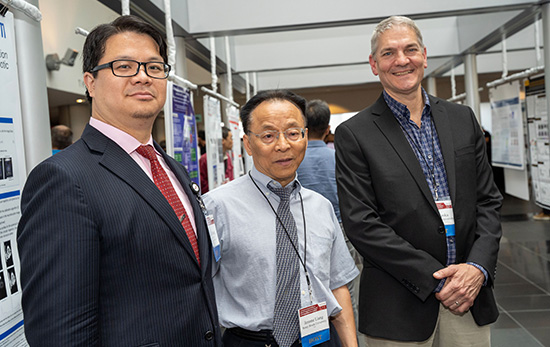Stony Brook and the Renaissance School of Medicine are committed to being the leading institutions in the field of medical imaging science. As such, for the first time they hosted a five-day international conference, Fully3D 2023, to discuss the latest research on X-ray CT, PET and SPECT imaging algorithms.
 Stony Brook Medicine, in particular the Department of Radiology, has been at the forefront of medical imaging research for decades, serving as the birthplace of MRI technology and diagnostic CT colonography (CTC), and making important contributions in the development of X-ray, CT, PET, SPECT, MRI, optical and multimodality imaging. Stony Brook maintains cutting-edge equipment to provide the highest quality images in the region. The new and growing PET Research Center (including the BAHL Molecular Imaging Laboratory and Cyclotron) has imaging capabilities that rival the best in the world. The Carol M. Baldwin Breast Care Center plays a leading role in providing services to the region. Pediatric radiology services are provided by sub-specialized board certified academic radiologists. In addition, Stony Brook’s long-standing partnerships with both Brookhaven National Laboratory and Cold Spring Harbor Laboratory has led to extraordinary discoveries and empowered Stony Brook to recruit talented faculty and students.
Stony Brook Medicine, in particular the Department of Radiology, has been at the forefront of medical imaging research for decades, serving as the birthplace of MRI technology and diagnostic CT colonography (CTC), and making important contributions in the development of X-ray, CT, PET, SPECT, MRI, optical and multimodality imaging. Stony Brook maintains cutting-edge equipment to provide the highest quality images in the region. The new and growing PET Research Center (including the BAHL Molecular Imaging Laboratory and Cyclotron) has imaging capabilities that rival the best in the world. The Carol M. Baldwin Breast Care Center plays a leading role in providing services to the region. Pediatric radiology services are provided by sub-specialized board certified academic radiologists. In addition, Stony Brook’s long-standing partnerships with both Brookhaven National Laboratory and Cold Spring Harbor Laboratory has led to extraordinary discoveries and empowered Stony Brook to recruit talented faculty and students.
So it’s no surprise that the Department of Radiology sponsored, along with Stony Brook University, Fully3D 2023. This 17th International Meeting on Fully 3D Image Reconstruction in Radiology and Nuclear Medicine was held for the first time on campus July 16 through July 21. The biennial research conference brought 180 scientists, students and industry researchers from around the world to SBU’s Charles B. Wang Center to present the latest research on the mathematics and theory behind X-ray CT (computed tomography), PET (positron emission tomography) and SPECT (single photon emission computed tomography) imaging. The focus of the conference was image reconstruction – the process of taking the raw data from medical imaging systems and generating optimized 3D images that radiologists use to diagnose disease. The location of the Wang Center was especially fitting because of the central importance of computational methods in image reconstruction.
Further highlighting Stony Brook’s leadership in the field, the event was co-chaired by three professors (pictured above) doing research in imaging science who are affiliated with the Department of Radiology. They were Dr. Jerome Z. Liang, Professor of Radiology, Biomedical Engineering, Electric and Computer Engineering, and Computer Science; Dr. Paul Vaska, Professor of Biomedical Engineering and Radiology; and Dr. Chuan Huang, former Associate Professor of Radiology who is now at Emory University but returned to work on this conference. All three co-chairs have national and international reputations in the field of medical imaging, particularly in reconstruction of low-dose CT (including CTC), hardware and methods for high-resolution and quantitative PET and SPECT, and advanced AI algorithms for PET and MRI clinical utility.
Vaska said Fully3D 2023 enhanced Stony Brook’s status as a major player in medical imaging science. Read more.

